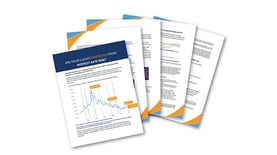Right now, it’s tough to find an S&P 500® cap on a fixed indexed annuity or indexed universal life product that will get a client excited. With the recent drop in the market and rates at an all-time low, you’re likely searching for a way to give your clients SOME hope of a credit in their indexed annuity or IUL policy. Have you considered a volatility control index? In this post, we dive into ways to evaluate them --

Unfortunately, a low-rate environment is nothing new, but it's prompted many insurance carriers to try and make products more appealing. One way they’ve done that is by offering volatility control indices. With the volatility of the market a pressing concern for clients (especially near-retirees), an index that seeks to minimize exposure to it can make sense…
Here’s the thing though:
Clients may not understand how they work and opt to stick with an S&P 500® capped strategy instead--- something they’re at least familiar with and you have no trouble explaining, right?
But then the annual statement comes out…
And disappointment sets in.
Are you interested in promoting a volatility control index, but first want to get a handle on them yourself? At this point, they might look a little too good to be true with participation rates over 100%.
Have your clients ever said something like this--
“So, I can only get up to 3% on this strategy, but with this index I’ve never heard of there’s virtually no limit to what can be credited? How is that possible?”
Clients could be a little confused or skeptical, so we need to help them understand how they work.
There's no doubt they're popular. Many indexed universal life insurance (IUL) and fixed indexed annuity (FIA) carriers have rolled out volatility control indices over the past few years. In fact, the Spring 2019 report from AMS indicated that 3 years prior, the total number of volatility control indices in the fixed indexed annuity space was just 12. As of the timing of that report, the number had jumped to 50.
But the question remains-- are they as good as they look? We believe they can be and here’s why:
Help meet multiple goals
In a time of uncertainty, clients may be hesitant to put their money in riskier positions while others may be looking to “buy low” in hopes the market rebounds. Both types of clients could benefit from putting a portion of their money into a volatility control index within their IUL or Fixed Annuity product.
Designed specifically for the ups and downs of the market
A volatility control index consists of multiple asset classes, including commodities, equities, bonds and cash and is monitored regularly so that when volatility reaches a certain level, specified within the rules of the index, a greater percentage of the funds would be allocated to fixed options like bonds to bring volatility back under a pre-determined level by the insurance carrier. If volatility is low— we may see more funds are shifted to equities by the insurance carrier in an attempt to capture a greater portion of the upside potential.
Can provide greater index crediting even in a down market
In the brief history of these type of indices offered within a fixed indexed annuity (FIA) or IUL, especially when the S&P 500® was down, we’ve seen double digit interest crediting in some insurance products with the volatility control crediting strategy. This is due in part to the strategy using a participation rate to calculate indexed interest in lieu of a cap – in addition to the ability to reallocate funds amongst different asset classes in response to volatility as mentioned above. In an environment when caps are extremely low, a volatility index with a participation rate may help a client to capture more of the potential upside of the index.
Lock-in any growth from crediting period to crediting period
Another benefit of these crediting strategies is that most times, they have an annual or bi-annual lock-in feature so that a client wouldn’t lose what’s already been credited to their contract or policy value. Keep in mind, their value could go down if there are other fees or charges being deducted.
Can be potentially beneficial in times of uncertainty
A client using a volatility control index is not directly invested in the market, but the indexed interest crediting is tied to the performance of the index. So, when no one is sure whether there will be ups or downs in the economic environment, it can be beneficial to diversify. A volatility control index provides a client an option to diversify amongst various asset classes held within the index, while still being protected from downside risk (a benefit inherent in a fixed indexed product) and help reduce the effects of volatility, and capturing some upside potential.
But why “volatility control” on an indexed annuity?
It's true that an indexed annuity or indexed life product is designed to capture as much of the upside as possible within the constraints of a cap or participation rate while being shielded from the downside. But right now and in the foreseeable future, a volatility control index may be an ideal way to capture even more of the upside of the market.
What makes one volatility control index different than the next?
I hope that we agree on this--
A financial professional should be aware of differences among these various indices. On the surface, volatility control indices might look the same, but there are few key areas of differentiation.
Within the index itself, you may want to research:
- Internal fees or spreads
- Volatility trigger level
- Features
- Crediting calculations
- Rates
- Bank or investment company who created the index
Another important question to ask
What is the carrier renewal rate history?
Part of what makes a volatility control index so intriguing is the higher participation rates. Because a volatility control index with a cash component has less volatility, option costs for the carrier are lower and more fixed allowing for higher rates and/or caps to be offered on new money.
If you see what you think is generous first-year rate, ask for the renewal rate history from the carrier. If they don’t provide that, you may want to question why not. Look at the minimum guaranteed rate as well. How low can it go? We work with at least one carrier where the participation rate would not go below 100%.
Back to the original question
It seems volatility control indices are here to stay, and they are built to help clients get greater risk-adjusted returns. However, finding out whether any index is as good as it looks requires research. It’s in everyone’s best interest for you to have an understanding yourself so that you can explain it to your clients. If you have questions about volatility indices, reach out to your Partners Advantage representative.





